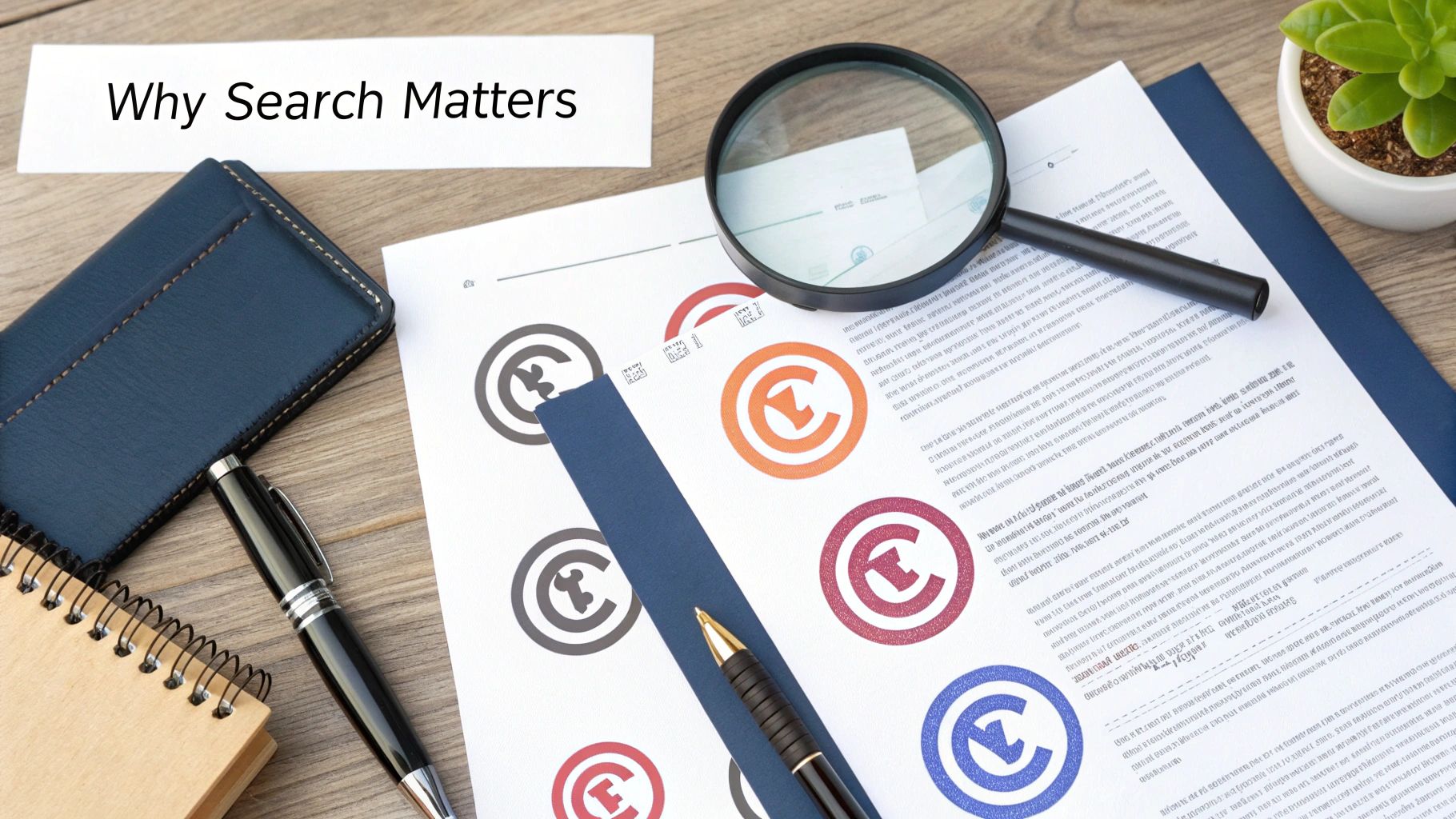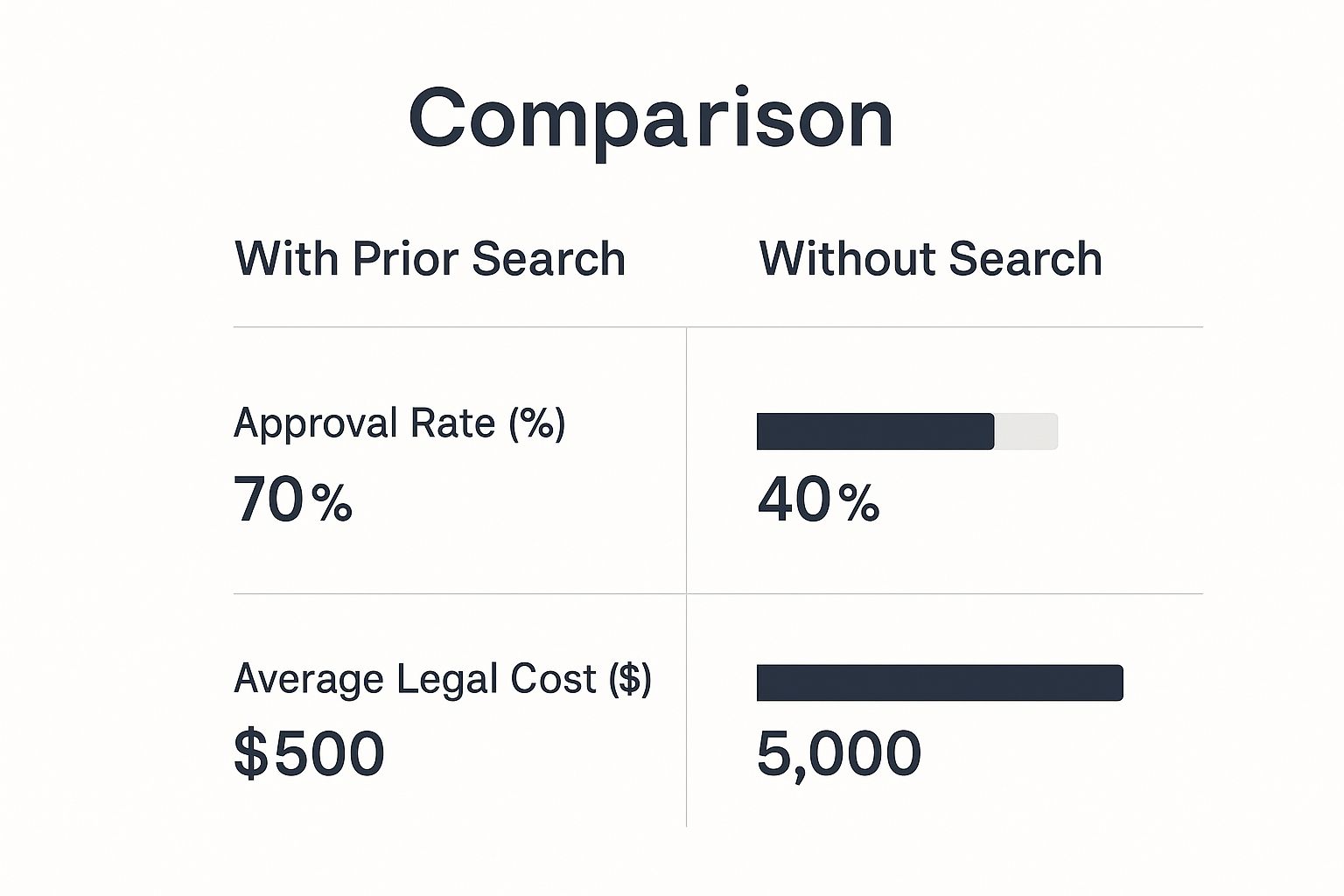Why Trademark Searches Matter (And When to Skip Them)

Let's be honest, trademark searches aren't exciting. But they are absolutely essential for protecting your brand. I've witnessed countless founders devastated by cease and desist letters, facing massive legal fees and forced rebrands. All because they skipped this one crucial step.
Trademark infringement isn't just legal jargon; it's about safeguarding your hard work. At Cordero Law, we're dedicated to building brands, not tearing them down. That's why a proper trademark search is so vital. And it's not just about federal protection.
State Vs. Federal Protection: The Real Story
Many online resources misrepresent the difference between state and federal trademark protection. State protection is limited, covering only your specific state. This might work for a local business, but it's insufficient for online sellers. Federal protection, granted by the USPTO (United States Patent and Trademark Office), provides nationwide coverage. This is the gold standard, the VIP pass to trademark security.
A trademark search involves using databases and software to identify existing trademarks similar to yours. This process is increasingly important due to the surge in global trademark filings. In 2023, almost 62% of global trademark filings were concentrated at just five offices, a significant increase. This highlights the need for a robust search strategy, especially in competitive markets. Learn more about global trademark trends. A thorough search is clearly essential.
(Side note: The WIPO Global Brand Database is an excellent resource for researching international trademarks, even if you're not planning global expansion yet. It’s good to be prepared.)
Okay, But Can I Ever Skip a Search?
Technically, yes. But it's incredibly risky. Unless your business is incredibly niche, a thorough search is non-negotiable. There are too many variables, too many potential conflicts, and the risk of expensive legal battles is too high. Do you really want to divert resources away from growing your business to fight a legal battle? You might even need Tax Debt Relief Companies in a worst-case scenario.
Also, if you're in NYC, you might be interested in checking out our sitemap for more helpful resources.
Why Bother?
The purpose of trademarks is to prevent confusion in the marketplace. They stop consumers from mistakenly purchasing a competitor's product believing it's yours. They also prevent others from capitalizing on your brand's reputation. A strong trademark is the foundation of a strong brand. Protect it. Seriously.
DIY Search Methods That Actually Work

The infographic above illustrates the impact of a trademark search on both your approval rate and legal costs. A thorough search beforehand significantly increases your chances of approval and minimizes potential expenses. The difference is stark: a proper search could mean the difference between spending $500 versus $5,000.
So, you're attempting a DIY trademark search. I understand budget constraints are a real factor. This guide focuses on actually finding potential conflicts.
TESS: Your First (and Sometimes Frustrating) Stop
The Trademark Electronic Search System (TESS) – it can be challenging to navigate. However, as the USPTO’s official database, it's a necessary starting point. The key is knowing how to use it effectively.
- Start Broad, Then Narrow: Don’t limit yourself to searching your exact mark. Explore synonyms, related terms, and variations.
- Phonetic Fun: Search for phonetic equivalents (words that sound like your mark) using the "Free Form" search option. This is a critical step that many overlook.
- Classes Matter: Trademarks are classified by goods/services. Research your relevant International Classes. Selling apparel won't necessarily conflict with a software company using the same name, but trademark law can be complex.
Even with these tips, TESS can be difficult to use.
Google-Fu: Unleashing the Power of Search
While TESS is essential, other methods can be surprisingly effective. Using Google with specific search operators can uncover real-world uses of similar marks that TESS might miss.
These operators can be technical, but understanding Boolean search (using AND, OR, NOT) is beneficial.
"Your Mark" + industry– Use quotes for exact phrases to see how competitors use similar names.site:*.com "Your Mark"– Restrict searches to specific top-level domains to find potential website conflicts.
Beyond the Basics: Digging Deeper
- Common Law Searches: TESS doesn't catch unregistered marks protected by "common law" (first use in commerce). This requires searching state business registries, industry publications, and the internet.
- Image Searches: If your logo is distinctive, an image search can reveal similar designs. Visual trademarks are important, just look at the Apple logo.
These searches require more in-depth research. While professional searchers can provide valuable assistance, understanding these strategies will protect your brand in the long run.
Before you embark on your search, consider the following resources:
This table compares different free and low-cost trademark search resources available to the public, highlighting their key features and limitations.
DIY Trademark Search Resources Comparison
| Resource | Best For | Limitations | Pro Tip |
|---|---|---|---|
| TESS | Comprehensive database of registered trademarks | Can be difficult to navigate; requires specific search strategies | Use Boolean operators and phonetic searching |
| Identifying real-world usage of similar marks | Results may not be comprehensive; requires familiarity with search operators | Combine with TESS for a more thorough search | |
| State Business Registries | Finding unregistered trademarks (common law) | Varies by state; can be time-consuming | Focus on states where you plan to operate |
| Google Images | Searching for visually similar logos | Limited to images available online | Useful for identifying potential design conflicts |
This table summarizes key resources for conducting a DIY trademark search. While TESS offers a comprehensive database, it can be challenging to use effectively. Supplementing your TESS search with Google, state business registries, and image searches can provide a more complete picture. Remember, while a professional search can be valuable, understanding these strategies is crucial for protecting your brand. Good luck with your trademark journey!
Advanced Search Techniques Most People Miss

Let's get down to business. A basic search on the USPTO website? That's just the tip of the iceberg. It's shocking how many people stop there. It's like bringing a knife to a gunfight.
I'm going to share the advanced trademark search techniques I use daily – the strategies that separate the experts from the amateurs. These techniques can help you uncover potential conflicts before they escalate into legal nightmares. I've even seen experienced attorneys overlook these crucial steps, which is a bit unsettling, considering what's at stake: your entire brand.
Boolean Operators: Not as Scary as They Sound
Boolean operators – AND, OR, NOT – are powerful tools in trademark databases. They act like advanced search filters. AND narrows your search (e.g., "coffee" AND "beans"). This helps you find trademarks related to both coffee and beans.
OR expands it (e.g., "coffee" OR "tea"). This is useful when searching for trademarks related to either coffee or tea. NOT excludes specific terms (e.g., "coffee" NOT "instant"). This helps you filter out trademarks related to instant coffee. This level of control is essential when navigating large databases. Surprisingly, many people are unaware of these operators.
Field Restrictions: Laser-Focus Your Search
Most trademark databases allow you to restrict your search to specific fields. This is a game-changer. Instead of searching the entire database, you can zero in on specific elements. These might include the mark’s literal elements (the actual words), the goods/services description, or the owner’s name.
For example, if you’re searching for "Apex," restricting your search to the goods/services field containing "clothing" will yield highly targeted results. I use these restrictions constantly. This is particularly helpful for international searches, where language barriers can add complexity.
Speaking of which, global trademark searching is paramount. The process has become more efficient thanks to specialized software. This market is experiencing significant growth. In 2025, it was valued at millions and is projected to expand considerably. Find more detailed statistics here.
Interpreting Search Results: It’s Not Always Black and White
Identifying a "similar" mark is just the first step. Assessing the real risk is where expertise becomes critical. Finding "close" matches doesn't necessarily mean they pose a threat.
This assessment involves considering factors like market overlap (are they targeting the same customers?), the strength of the existing mark (is it well-known or relatively unknown?), and the overall impression created by both marks. It's more nuanced than simply checking a box. Read also: How to master your sitemap. This process requires careful consideration.
Documenting Your Search: Cover Your… Assets
Meticulous documentation is crucial, even though it might seem tedious. If your trademark is ever challenged, a thorough record of your search proves your due diligence. Keep screenshots, printouts, and notes of everything. This includes search terms, databases used, dates, and your analysis of potential conflicts.
This isn't just about fulfilling legal requirements; it's about building a strong defense. Proper documentation can save thousands in legal disputes. Trust me on this.
International Searches: Think Global, Act… Global?
In today's interconnected marketplace, limiting your trademark search to the US is shortsighted. Even if you aren't planning international expansion immediately, what about the future? Searching international databases (like WIPO's Global Brand Database) can identify potential obstacles down the road. It's a small investment that can prevent significant problems later, especially if your business grows rapidly. This process can be intricate, like searching for a single grain of sand on a vast beach, but it's vital.
Analyzing Results Without Freaking Out
So, you've braved the complexities of TESS and maybe even indulged in some Google searches. You've got your search results. Now what? Most people seem to fall into two camps: frozen by fear over every remotely similar mark or recklessly charging ahead, ignoring all warning signs. Neither approach is ideal. This is where we separate the real threats from the… not-so-real threats. The art of staying calm under pressure.
Understanding "Likelihood of Confusion"
This is the core of trademark law. Forget the legal jargon for a moment. It boils down to this: Is your mark so similar to an existing one that consumers might get confused? Would they accidentally buy your product thinking it’s someone else’s? (Which, incidentally, is precisely why trademarks exist – to prevent this very confusion). It’s about protecting consumers and your brand.
Here’s the key: a “similar” mark isn't automatically a dealbreaker. Many factors contribute to this analysis. It's not just about matching letters. This test, this "likelihood of confusion" standard, is what the USPTO and courts use. And, frankly, it’s what I use every single day.
Factors That Actually Matter (and Some That Don’t)
Look, unlike some articles that simply say "Look for similar marks"—(helpful, I know)—I'm giving you the real information. The actual framework attorneys like myself use.
Market Overlap: Are you both selling coffee? Or are you selling coffee and they’re selling tractors? Big difference. (Although, coffee-flavored tractors… now there’s an idea). If your markets overlap, the risk is higher. If they don't…well, you might be in the clear.
Sight, Sound, and Meaning (The Trademark Trinity): How similar do the marks look? How similar do they sound? Do they evoke the same feeling or idea? These are all considered. For example, “Cordero Coffee” and “Cordeiro Coffee” might be confusingly similar, despite a slight spelling difference.
Strength of Existing Mark: Is the existing mark famous (like, Nike-level famous)? Or is it relatively unknown? Stronger marks get broader protection. It influences how far the "likelihood of confusion" extends. A weaker mark? Not so much.
Sophistication of Consumers: Are your customers likely to carefully examine labels? Or are they impulse buyers? More discerning customers are less likely to be confused. Think: buying a car vs. grabbing a candy bar.
Organizing Your Findings: Don’t Just Wing It
Okay, now that you know what to look for, how do you actually analyze the results? Here’s my (slightly unconventional) method:
- The “Uh Oh” List: Create a list of potentially problematic marks. Anything that even remotely raises a concern. Don't overthink it at this stage.
- The “Actually, It’s Fine” List: Now, go through your “Uh Oh” list and apply the likelihood of confusion factors. Many marks will quickly move to this list.
- The “Lawyer Up” List: For the remaining few, ask yourself: "Am I comfortable making this decision alone?" If not, consult an attorney. (It’s what we’re here for.)
Also, document everything. Seriously. Search terms, dates, databases, your analysis. (Because if you do end up in a legal dispute—knock on wood—this documentation is invaluable). It demonstrates you didn't just blindly rush forward. It’s like having receipts.
Making the Call: Proceed, Pivot, or Punt
After all this, you should have a much clearer understanding of the trademark landscape. You’ll likely fall into one of these categories:
- Green Light: Proceed with your mark!
- Yellow Light: Minor tweaks might be needed. Maybe a slight spelling variation or adding a descriptive term.
- Red Light: Time to brainstorm alternatives. This might be frustrating, but it’s far less frustrating than dealing with a trademark infringement lawsuit. Sometimes the smartest move is knowing when to walk away.
(I realize this section might seem a bit… detailed. Trademark law can be complex. But hopefully, this framework provides some clarity and a sense of control. It's better to be over-prepared than under-prepared). And, hey, at least you're not trying to decipher tax code, right? Now, onward!
Trademark Search Mistakes I've Seen Destroy Brands

Look, I get it. Trademark searches aren't exciting. They're not the fun part of building a brand. But they are the foundation. A shaky foundation can lead to disaster. I've seen it firsthand: brands crumbling, founders stressed, money wasted. It's not pretty. This section? It's my attempt to save you from that pain.
The Exact Match Myth (and Other Rookie Moves)
Seriously, searching only for exact matches is a rookie mistake. The trademark system doesn't care if your name is almost unique. Close enough isn't good enough.
Think of it like this: you wouldn’t name your band “The Rolling Stones” just because you added an extra “s.” Right? The same principle applies to trademarks. Minor variations often won’t cut it.
This isn't just about identical names; it’s about preventing consumer confusion. Similar names, similar logos, even similar sounds can be a problem. Think phonetically. "Cordero Coffee" and "Cordeiro Coffee"—see the problem? It’s subtle, but it can trigger a legal challenge. Legal challenges are expensive.
Another classic blunder? Ignoring international markets. Even if you're only operating in the US now, what about the future? The internet is global, and trademarks can clash across borders. Limiting your search is limiting your future. In conducting a trademark search, consider the scale of global trademark activity. In 2019, there were 3,789,328 trademark applications globally. Find more detailed statistics here. International searches matter.
You might also be interested in: How to master…
The “I’ll Just Add My Industry” Fallacy
“Acme Coffee Roasters” is different from “Acme Software,” right? Wrong. Adding your industry to a generic name doesn't make it unique. It can even weaken your mark.
It's like saying, “I'm claiming this tiny corner of the ‘Acme’ universe, but the rest is fair game.” Nope. Doesn’t work that way. Unless you want constant infringement battles.
Future-Proofing: Because Brands Evolve
Think about where your brand might go. Are you selling coffee now? Might you expand into tea later? Pastries? Your trademark search needs to anticipate these possibilities.
I had a client who spent a fortune branding a fitness app, only to discover an identical trademark for fitness equipment. $30,000 down the drain. Don’t be that client.
The Trademark System Is Unforgiving (But Predictable)
The trademark system can feel brutal. It doesn’t care about your investment, your logo, or your intentions. It operates on rules and precedent.
But here’s the thing: it’s predictable. With a thorough and strategic trademark search, you can avoid most of these pitfalls. You can navigate the system, protect your brand, and build a solid foundation for future growth. And that’s the goal.
When DIY Won't Cut It: Bringing In The Pros
I know what you're thinking – "Of course a lawyer wants me to hire a lawyer." But this isn't about pushing everyone towards professional help. I believe in DIY whenever possible. (I even built my own slightly wobbly standing desk and saved a few hundred bucks.) This is about recognizing when DIY is sufficient and when it becomes a risk. Sometimes, calling in the pros is less of an expense and more of a smart investment.
Know Your Limits, Play Within Them
A simple, low-risk trademark in a relatively uncrowded market? DIY might be okay. (Emphasis on might. Even then, unexpected issues can arise.) You can probably handle it yourself. Maybe.
But imagine you're raising capital. Investors want rock-solid trademark protection. They likely won’t be impressed by a homemade trademark search. Or, what if you’re planning national or international expansion? Your risk profile just skyrocketed. Handling that yourself might not be the wisest move.
The same applies to highly competitive industries like fashion or tech. These markets are full of aggressive brands with aggressive lawyers. DIY in that arena is like swimming with sharks armed with a pool noodle.
What the Pros Actually Do (Besides Bill You)
A comprehensive trademark search from an experienced attorney or search firm goes beyond using TESS. It involves advanced techniques like Boolean searches, field restrictions, searching international databases, and common law searches (don't underestimate unregistered marks!). Plus, professionals have access to paid databases with better search functionality.
To help illustrate the differences, let's take a look at the following comparison:
DIY vs. Professional Trademark Search Comparison
This table compares the benefits, limitations, costs, and appropriate scenarios for DIY trademark searches versus hiring a professional service.
| Factor | DIY Search | Attorney Search | Search Company |
|---|---|---|---|
| Cost | $0-$50 | $250-$2,000+ | $50-$200 |
| Depth of Search | Limited to free, publicly available databases | Comprehensive, including paid databases and common law searches | Varies, some offer more comprehensive options than others |
| Expertise | Limited, requires self-education | Extensive legal knowledge and experience | Varies, some companies specialize in trademark searches |
| Risk Assessment | Difficult to assess potential conflicts accurately | Professional analysis and risk assessment provided | Limited risk assessment capabilities |
| Best For | Simple, low-risk trademarks in uncrowded markets | High-risk trademarks, complex situations, international expansion | Budget-conscious individuals seeking a more thorough search than DIY |
As you can see, the level of protection and peace of mind offered by professional searches often outweighs the cost, particularly for businesses with serious growth aspirations.
Show Me the Money (How Much Does This Cost?)
Pricing varies, but here's a general idea of what a comprehensive search might cost:
- DIY (with free tools): $0-$50
- Knockoff Search Company: $50-$200
- Basic Attorney Search: $250-$750
- Comprehensive Attorney Search: $750-$2,000+
The more specific your industry and goods/services, the less expensive the search should be. "Full availability" searches, which cover everything, are the most expensive but offer the greatest level of assurance.
Picking the Right Pro (Key Questions to Ask)
Don't just hire the first attorney you find. Ask questions:
- What databases do you search? (Should include more than just TESS)
- Do you search for common law marks? (Critical)
- What’s your experience in my industry? (Niches matter.)
- Can you provide references?
- How much does it cost? (Be upfront about your budget.)
Keeping Costs Down (Without Sacrificing Quality)
Attorneys can be expensive, but there are ways to manage costs. Communicate your budget clearly upfront. Be organized and provide as much information as possible about your brand and target market. The more organized you are, the more efficiently they can work.
